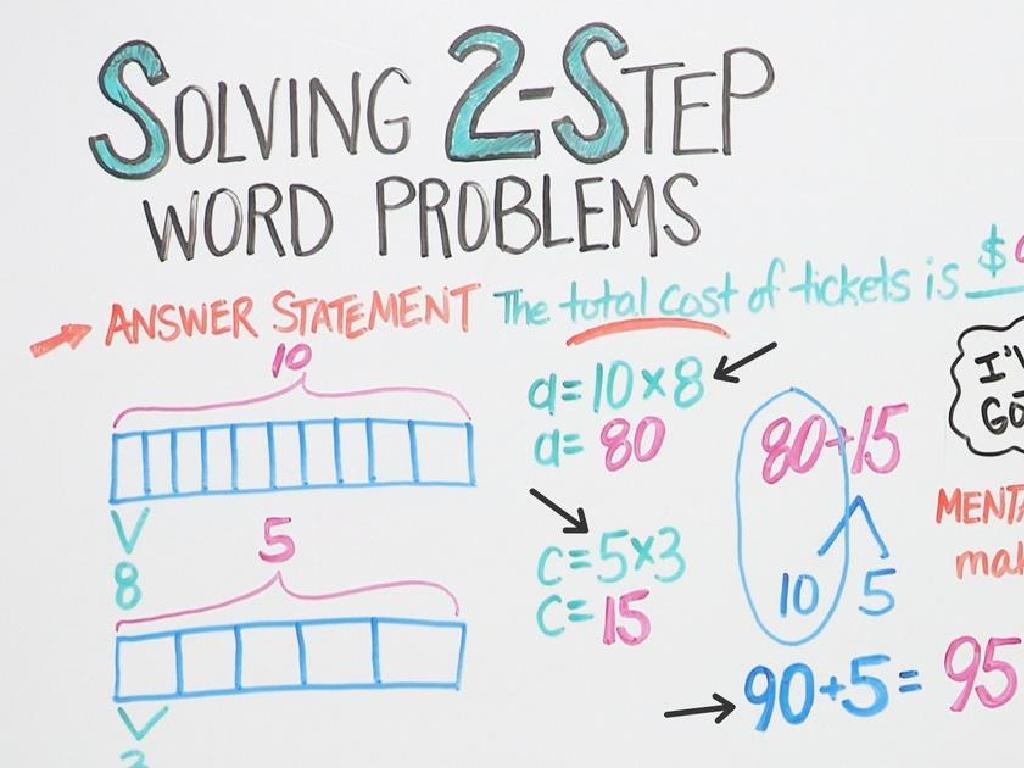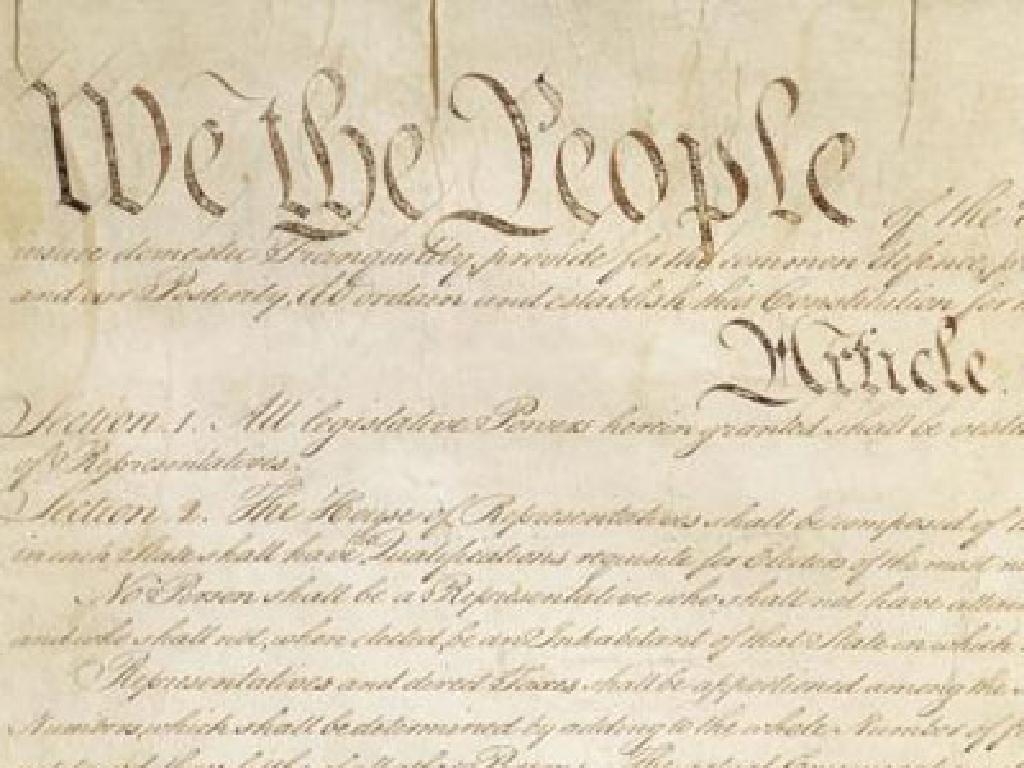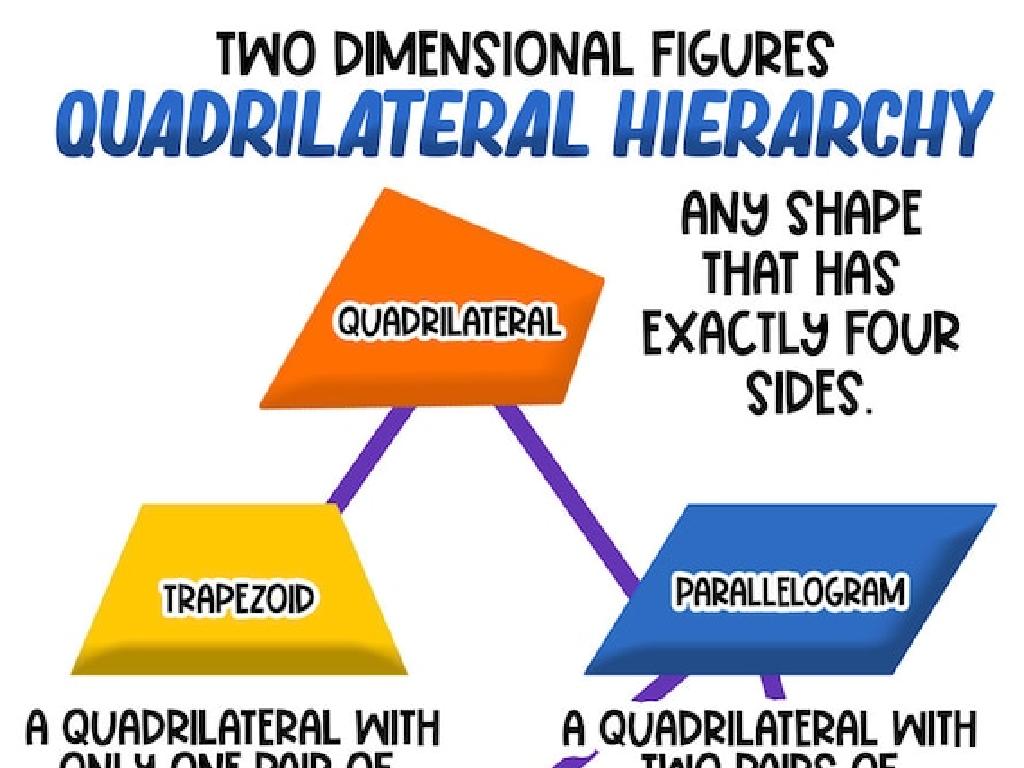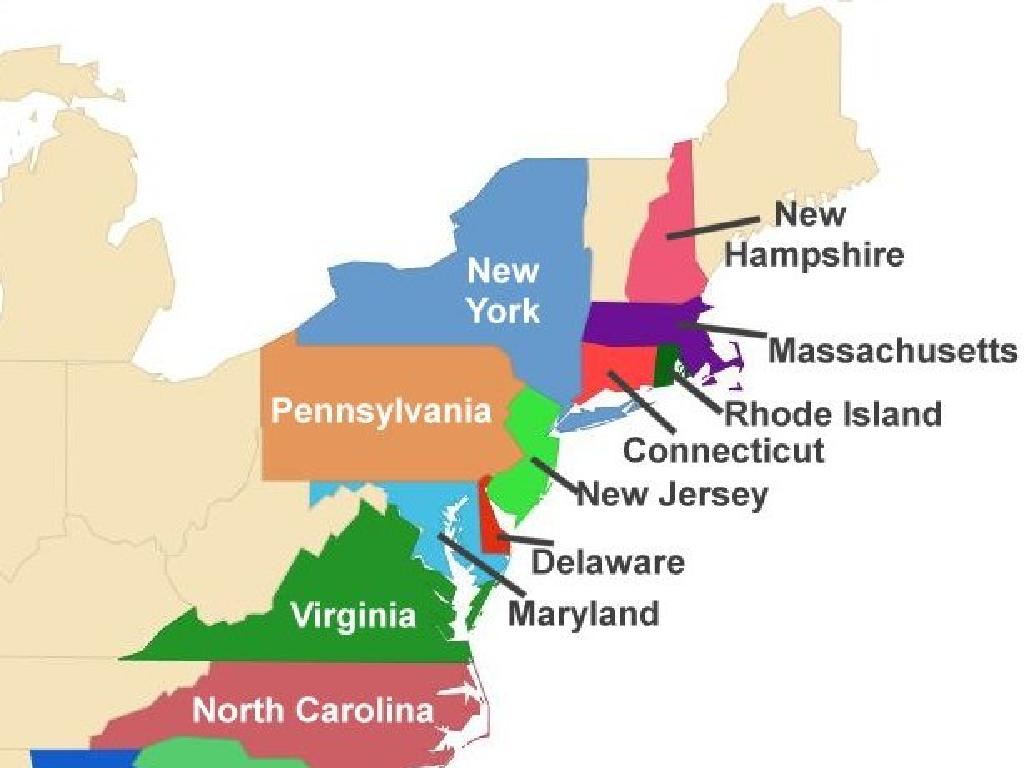Number Of Sides In Polygons
Subject: Math
Grade: Fifth grade
Topic: Polygons
Please LOG IN to download the presentation. Access is available to registered users only.
View More Content
Welcome to the World of Polygons!
– What are polygons?
– A polygon is a flat shape with straight lines that are fully closed.
– Find polygons in daily life
– Look around to see shapes like stop signs (octagons) or picture frames (rectangles).
– Polygons are 2D with straight sides
– Each side must be straight, not curved, for the shape to be a polygon.
– Counting sides of polygons
|
Introduce students to the concept of polygons by defining them as two-dimensional shapes with straight, fully closed sides. Encourage students to observe their surroundings and identify items that resemble polygons, such as street signs, tiles, or books. Explain that the sides of polygons are always straight and never curved, which distinguishes them from other shapes like circles. To solidify their understanding, have students practice counting the sides of various polygons, both in the classroom and from their observations at home or outside. This activity will help them recognize and differentiate between types of polygons based on the number of sides.
Identifying Polygons
– What defines a polygon?
– A polygon is a flat shape with straight sides that are fully closed.
– Comparing polygons and non-polygons
– Non-polygons may have curves or not be fully closed.
– Classroom activity: Find polygons
– Look around and list items that are polygons.
– Discuss findings with the class
– Share and explain why they are polygons.
|
This slide introduces students to the concept of polygons, emphasizing the characteristics that define them, such as being a flat shape with straight, fully closed sides. Contrast polygons with non-polygons by highlighting that non-polygons may have curved sides or open shapes. For the activity, students will search the classroom for real-life examples of polygons, such as windows, books, or tiles. Afterward, they will discuss their findings, explaining why the shapes they chose are considered polygons. This will help them apply their understanding of polygons to the world around them. Provide guidance on identifying and classifying shapes and encourage participation from all students.
Exploring Polygon Sides
– Count sides of different polygons
– Learn names based on side count
– Triangle: 3 sides
– A shape with three straight sides and angles
– Quadrilateral: 4, Pentagon: 5
– Four-sided figure, and five-sided figure respectively
|
This slide is aimed at helping fifth-grade students understand the concept of polygons and how to identify them based on the number of sides they have. Start by explaining what polygons are and then demonstrate how to count the sides of various shapes. Introduce the names of polygons such as triangles, quadrilaterals, and pentagons, and associate these names with the number of sides they have. Use visual aids like pictures of different polygons to help students count the sides. Encourage students to draw their own polygons and practice naming them. This foundational knowledge will be crucial for their understanding of more complex geometric concepts.
Regular vs. Irregular Polygons
– Define regular polygons
– A regular polygon has all sides and angles equal, like a square.
– Define irregular polygons
– An irregular polygon has sides and angles that are not all the same, like a rectangle.
– Differences with examples
– Regular polygons look ‘even’ all around. Irregular ones do not. For example, compare a hexagon to a trapezoid.
– Classify shapes activity
|
This slide introduces students to the concept of regular and irregular polygons. Regular polygons have sides and angles that are all equal, such as equilateral triangles or squares. Irregular polygons have sides and angles that are not equal, such as rectangles or trapezoids. Use visual examples to help students see the difference. Encourage students to look around the classroom or at home for objects that resemble these shapes. As an activity, students can classify shapes they find into regular or irregular polygons, fostering hands-on learning and reinforcing the concepts taught.
Exploring Polygon Properties
– Polygons: Sides, vertices, angles
– A polygon has straight sides, points called vertices, and angles inside.
– Side count shapes the polygon
– The number of sides determines the polygon’s name, like triangle (3), quadrilateral (4).
– Activity: Draw & label polygons
– Use a ruler to draw polygons and write the number of sides, vertices, and angles.
|
This slide introduces students to the basic properties of polygons, including sides, vertices, and angles. Emphasize that polygons are 2-dimensional shapes with straight sides that meet to form a closed figure. Explain how the number of sides dictates the name and shape of the polygon. For the activity, provide students with rulers and have them draw various polygons, such as triangles, quadrilaterals, pentagons, and hexagons. They should then label each with the correct number of sides, vertices, and angles. This hands-on activity will help solidify their understanding of polygon properties. Offer guidance and ensure they understand the relationship between the number of sides and the polygon’s name.
Perimeter of Polygons
– Understanding perimeter
– Perimeter is the total distance around a shape.
– Calculating polygon perimeters
– Add up the length of all sides for polygons.
– Example: Pentagon perimeter
– If a pentagon has sides of 3 cm, the perimeter is 3 cm x 5 sides.
– Practice with different shapes
|
The perimeter is an important concept in geometry that refers to the total distance around the edge of a polygon. To calculate the perimeter, students should learn to add the lengths of all the sides of the polygon. For regular polygons, like a pentagon with equal sides, simply multiply the length of one side by the total number of sides. Use the example of a pentagon to illustrate this concept, and then encourage students to apply this method to various polygons, both regular and irregular, as practice. This will help them understand how to approach finding the perimeter in different scenarios.
Class Activity: Polygon Creation
– Let’s build our own polygons!
– Use straws and connectors
– Count the sides of your polygon
– How many straws did you use? That’s the number of sides!
– Share your polygon with the class
– Tell us about your polygon’s sides
|
This activity is designed to help students understand the concept of polygons by creating them with physical materials. Provide students with straws and connectors, and instruct them to build various polygons. Once they have constructed their polygons, ask them to count and record the number of sides each shape has. Encourage them to share their polygons with the class and discuss the number of sides. This hands-on activity not only reinforces the concept of polygons and their sides but also fosters communication and presentation skills. Possible variations of the activity could include challenging students to create a specific polygon, comparing and contrasting different polygons, or even exploring the concept of regular versus irregular polygons based on side length.
Polygon Scavenger Hunt Activity
– Find classroom items matching polygons
– Work in pairs for the hunt
– Discuss common and rare polygons
– Were squares or triangles more common?
– Reflect on the activity
– Why do you think some shapes were harder to find?
|
This class activity is designed to help students recognize polygons in everyday objects and understand their prevalence in the environment. Students will work in pairs to encourage collaboration. After the scavenger hunt, lead a discussion to reflect on which polygons were most commonly found and which were rare, and why that might be. Encourage students to think about the properties of polygons and their functionality in design and objects. Possible activities: 1) Finding shapes in classroom objects, 2) Creating a tally chart of found shapes, 3) Drawing items that match polygon shapes, 4) Comparing findings with another pair, 5) Presenting their most interesting find to the class.
Wrapping Up: Polygons and Their Sides
– Recap: Polygons and sides
– Remember, polygons are 2D shapes with straight sides
– Importance of polygon knowledge
– Knowing polygons helps in geometry, art, and design
– Preview: Angles in Polygons
– Next, we’ll learn how angles give polygons shape
– Class activity: Quick Quiz
– Let’s review with a fun quiz on today’s lesson!
|
As we conclude today’s lesson, it’s crucial to review the key points about polygons and their sides to reinforce learning. Understanding polygons is fundamental in geometry, which has practical applications in various fields such as art, architecture, and design. Previewing the next lesson on angles will pique students’ interest and provide continuity. To assess understanding, conduct a quick quiz with questions about different polygons and their number of sides. This activity will help solidify the concepts learned today and prepare students for the upcoming lesson on angles within polygons.






